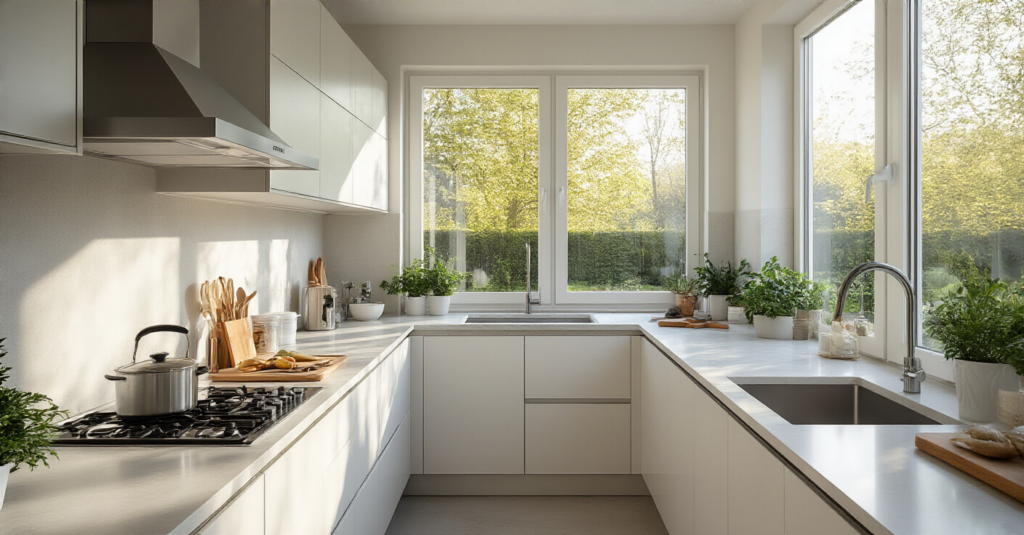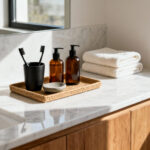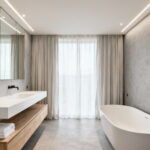You know what drives me nuts? Walking into a stunning, expensive new kitchen and realizing it feels like a sterile operating room, completely walled off from the world. People spend a fortune on a garden, a beautiful view, or a great patio, and then design the one room they spend the most time in to completely ignore it. They put the sink against a blank wall instead of under a window. They block the path to the deck with a clunky island. It’s a huge missed opportunity.
The secret to a kitchen that truly feels good isn’t just about having the latest cabinets or the trendiest backsplash. After years of designing spaces that blur the line between inside and out, I’ve realized the best kitchens aren’t designed from the inside out. They’re designed from the outside in. It’s not about following a checklist of design trends—it’s about using your kitchen as a bridge to the natural world. These 23 ideas aren’t just a list; they’re a new way of thinking about the heart of your home.
Strategic Planning for a Functional Kitchen Layout (Part 1)
Alright, let’s get the foundation right. Most designers talk about layouts in a vacuum, as if your kitchen exists on a piece of paper. But your kitchen exists in a home, on a piece of land. So, before you pick a single paint chip, you need to think about how this space connects to everything around it, especially the outdoors.
1. Conduct a Thorough Kitchen Activity Audit for Optimal Flow
People think an “activity audit” sounds corporate and complicated. It’s not. It’s about watching how you actually live. For one week, just pay attention. Where do you walk? Where do the kids drop their backpacks? Most importantly for me, how do you get outside? Do you carry a heavy platter of food for the grill through a narrow doorway, bumping your elbow every time? That’s a major workflow problem.
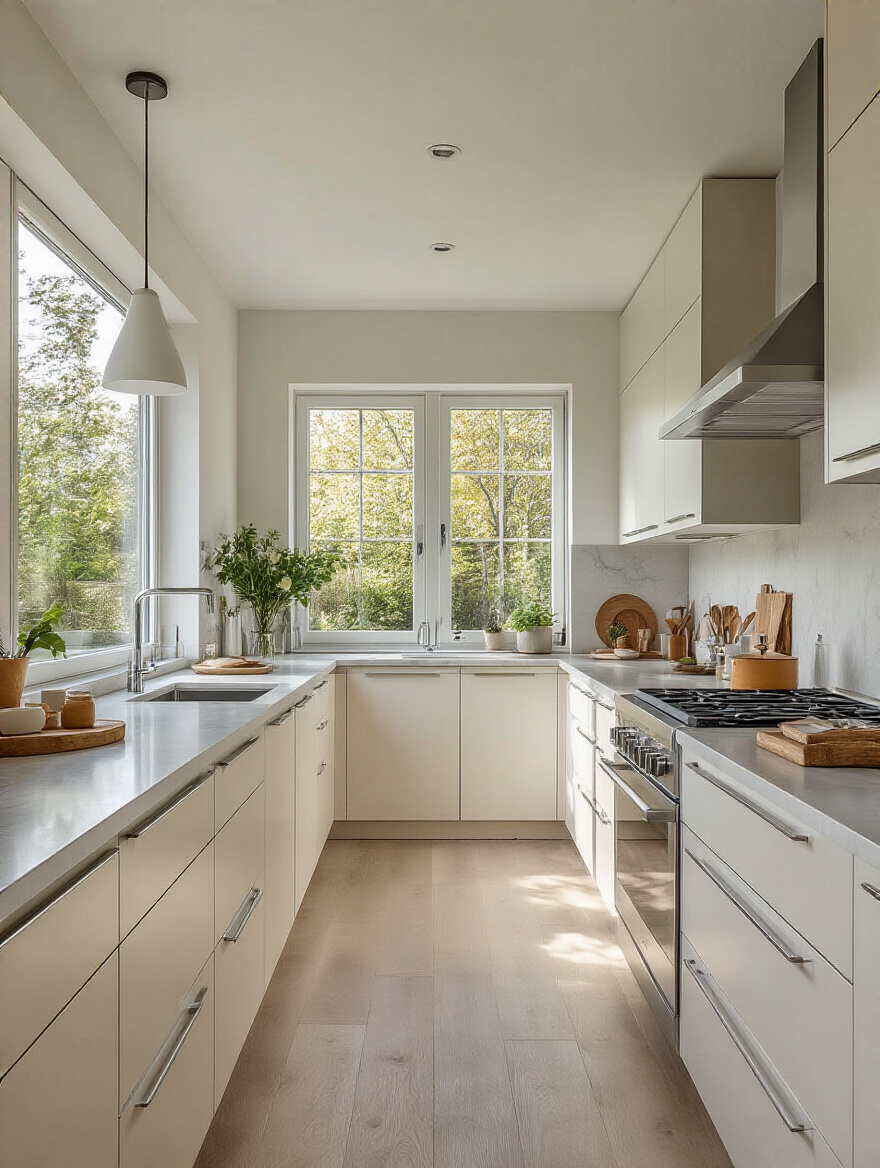
The real win here is mapping your path from the fridge to the prep counter to the stove, and—critically—to the patio door. The goal is to create an effortless dance between your indoor kitchen and your outdoor one. The noise is all the online quizzes that tell you your “kitchen style.” What actually matters is creating a layout where you’re not constantly bumping into things or backtracking. Your kitchen should feel like a gentle current, not a series of rapids and eddies.
A client once had their heart set on a huge central island. But their main path to the back deck was right where they wanted to put it. We spent an afternoon just walking the “paths”—from the garage with groceries, from the dining room with plates, from the kitchen to the grill. They realized the giant island would become a frustrating barrier. We redesigned it as an L-shaped peninsula, which preserved the open pathway to the outside. That simple shift completely changed how they lived in their space.
2. Map Out an Ergonomic Work Triangle for Maximum Efficiency
The “work triangle”—connecting the fridge, sink, and stove—is classic advice for a reason. It works. But I call BS on stopping there. In today’s world, for anyone who loves to cook outdoors, there’s a fourth point: the grill. Your kitchen layout is fundamentally flawed if it doesn’t consider the grill an essential appliance. The door to your deck or patio is a portal, and it needs to be an integral part of this flow.
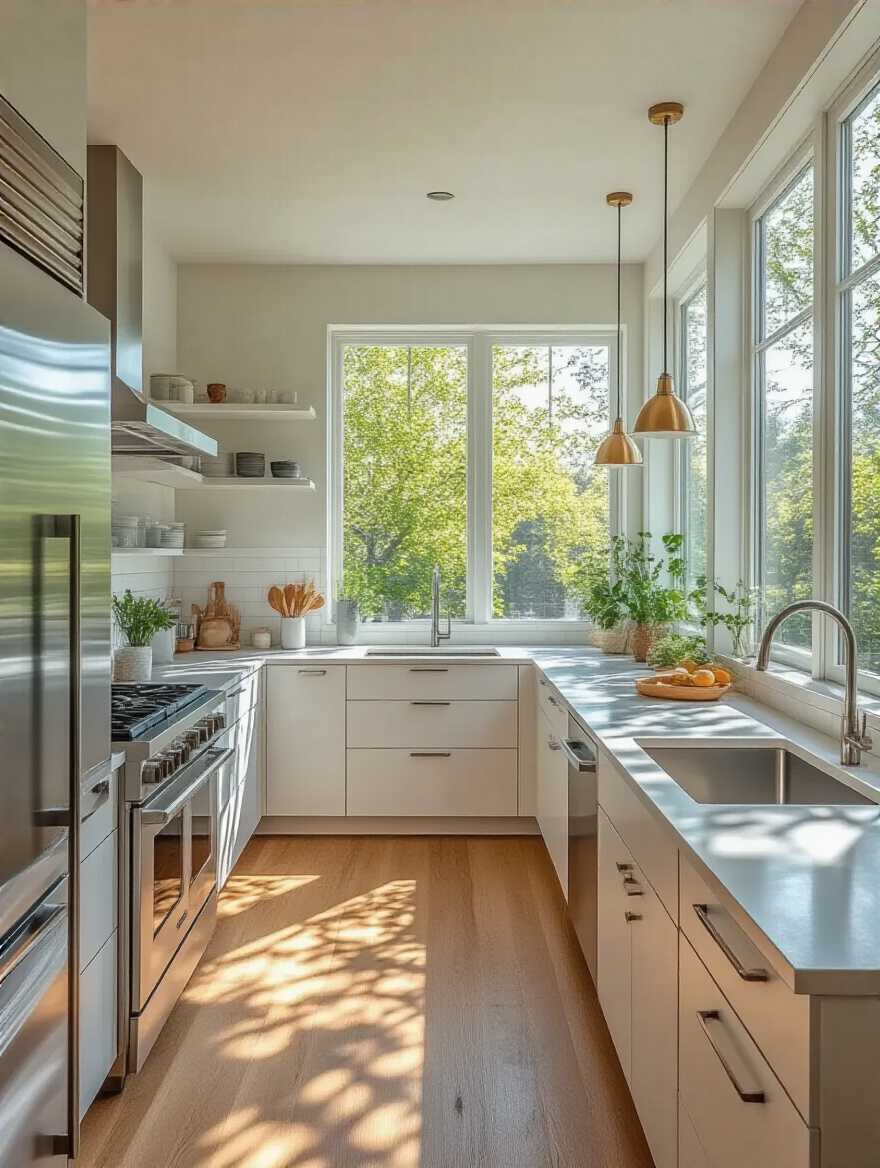
So, when you map your triangle, think of it as a diamond. How easily can you get from the fridge (to grab the steaks), to the sink (to wash the vegetables), and then out the door to the grill? Can you do it without navigating a maze? A perfect setup has a clear, wide path to the outside, ideally with a countertop “landing strip” right by the door to set down trays and tools. This is the shortcut to a kitchen that truly supports an indoor-outdoor lifestyle.
A friend of mine renovated his kitchen and agonized over the perfect interior layout. He forgot about the grill. Now, every time he barbecues, he has to carry dripping, marinated meat across his brand-new hardwood floors because the most direct path is blocked. Don’t be that guy. Think about the entire cooking process, from pantry to patio plate.
3. Define Clear Kitchen Zones to Enhance Organization and Access
Zoning is just a smart way of saying “put stuff where you use it.” You have a cooking zone by the stove with pots and spices, and a cleaning zone by the sink with soap and towels. Simple. But let’s take it a step further. If your kitchen is going to connect seamlessly to the outdoors, you need an “al fresco zone.” This is a total game-changer, and something most designers completely overlook.
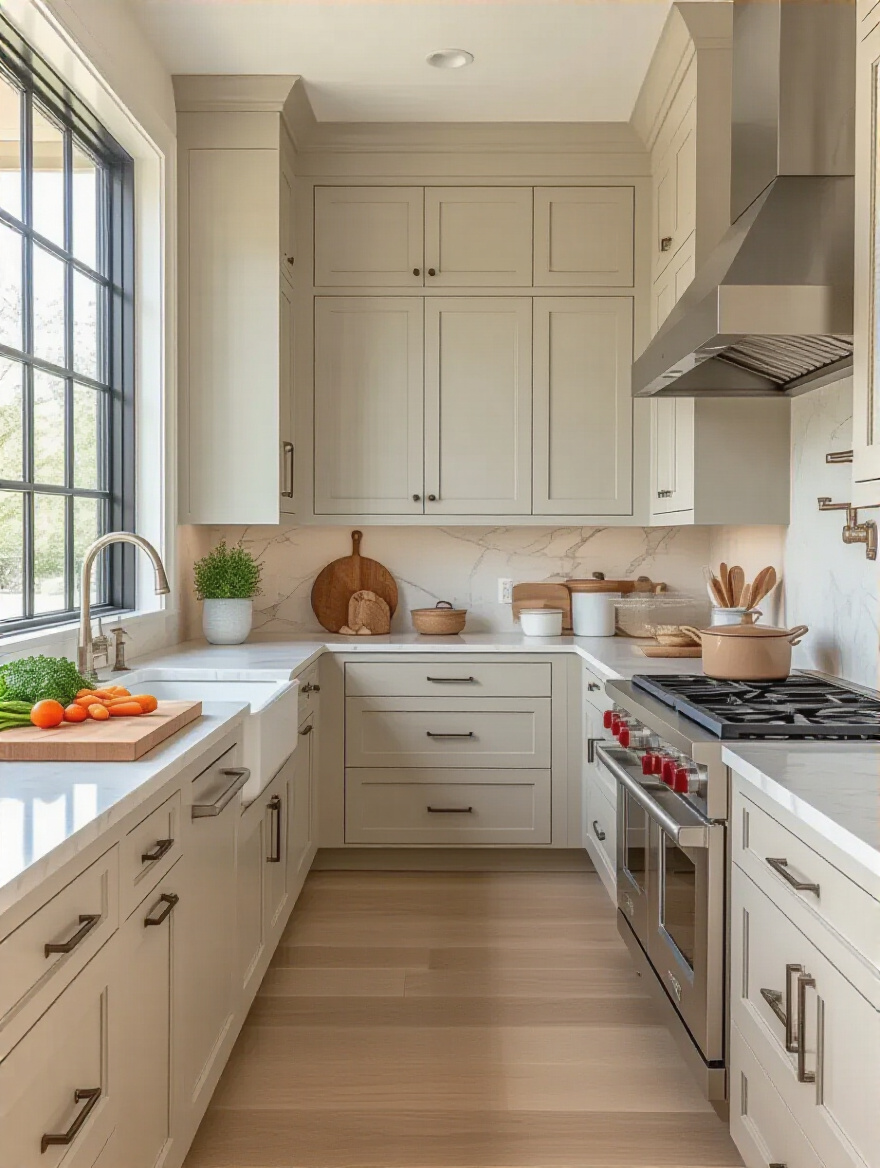
This zone should be the cabinet or set of drawers closest to the door leading outside. This is where you store everything you need for outdoor dining: melamine plates, acrylic glasses, serving platters, big salad bowls, grilling tools, citronella candles. No more running around the entire kitchen gathering things while your guests are waiting. Everything is in one place, ready to go. It makes spur-of-the-moment outdoor dinners feel effortless instead of like a major production.
One of the smartest things I ever did in my own home was dedicate a tall pantry cabinet next to the back door as our al fresco zone. We even keep a stack of outdoor-friendly blankets in there for cool evenings. It’s the ultimate shortcut to using our outdoor space more often. It removes all the friction.
4. Assess Your Home’s Natural Light for Ideal Appliance Placement
This is where my landscape architect brain really kicks in. Most articles will tell you to place appliances for workflow, which is true. But the most important element in any room, and especially a kitchen, is the sun. Before you place a single thing, you need to understand how light moves through your space from morning to evening, and how it changes with the seasons.
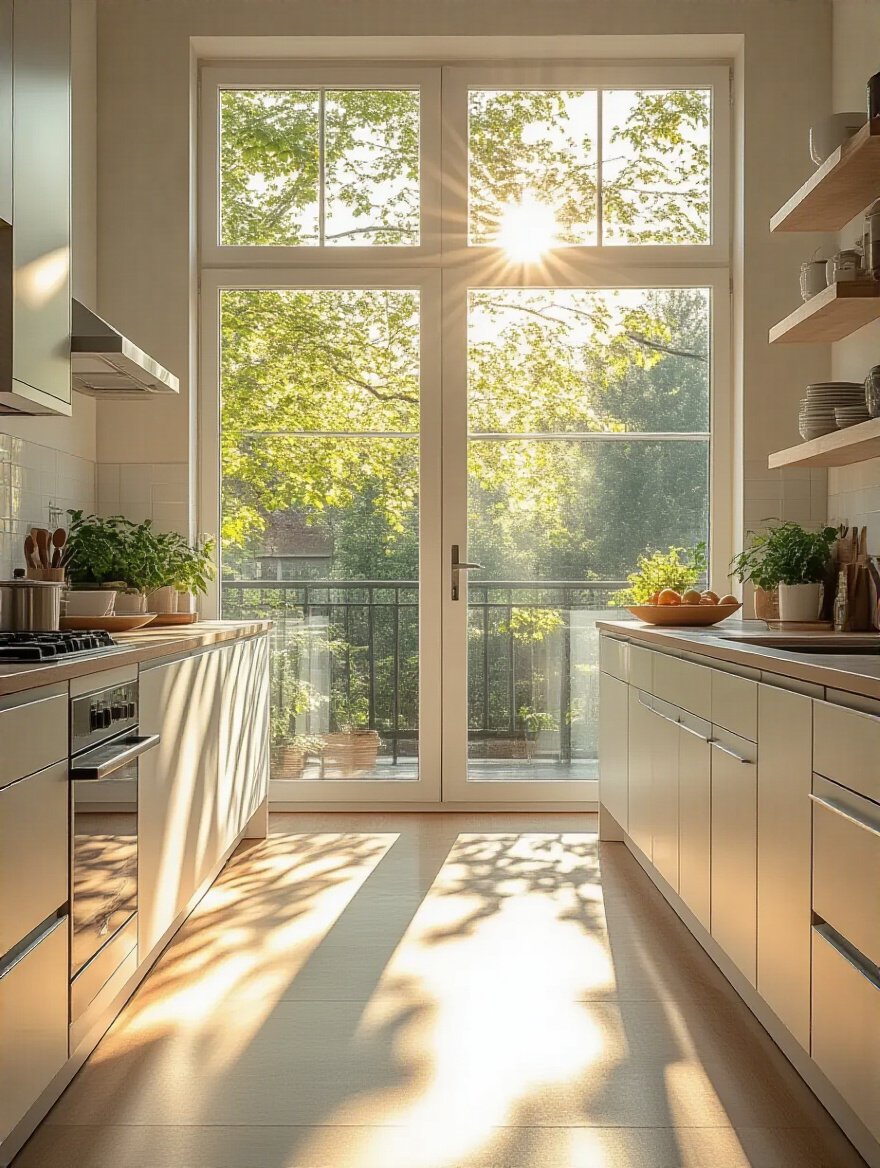
A kitchen flooded with morning light is an incredible place to start your day. Why would you stick your fridge there, a big box that couldn’t care less about the view? Put your sink or a small breakfast nook in that spot. A sink with a view of the garden is non-negotiable for me. It turns a daily chore into a moment of connection with nature. Likewise, avoid putting your refrigerator where it will get blasted by hot afternoon sun; it will just have to work harder, waste energy, and die sooner. Work with nature, not against it.
A shortcut? Spend a full day in your empty kitchen space before you start planning. Take pictures at 9 am, noon, and 4 pm. See where the light lands. Those sunny spots are prime real estate—don’t waste them on a wall of cabinets. Let the sun’s path dictate the rhythm of your design.
Now that we’ve oriented the kitchen in its environment and established a flow that respects the connection to the outdoors, we can start thinking about the bigger structural pieces. This is where you can make bold moves that will fundamentally change how your home feels.
Strategic Planning for a Functional Kitchen Layout (Part 2)
Thinking bigger isn’t about spending more money; it’s about making smarter, more impactful decisions. It’s about questioning the very walls that define the space and imagining a more fluid, open way of living that technology can support, not complicate.
5. Strategically Integrate Smart Home Technology from the Blueprint Stage
I’m not a huge tech guy for tech’s sake. A smart fridge that tells me I’m out of milk seems like a solution in search of a problem. But smart technology that helps connect you to the natural environment? Now you’re talking. When you’re in the blueprint stage, think about how tech can enhance that indoor-outdoor flow.
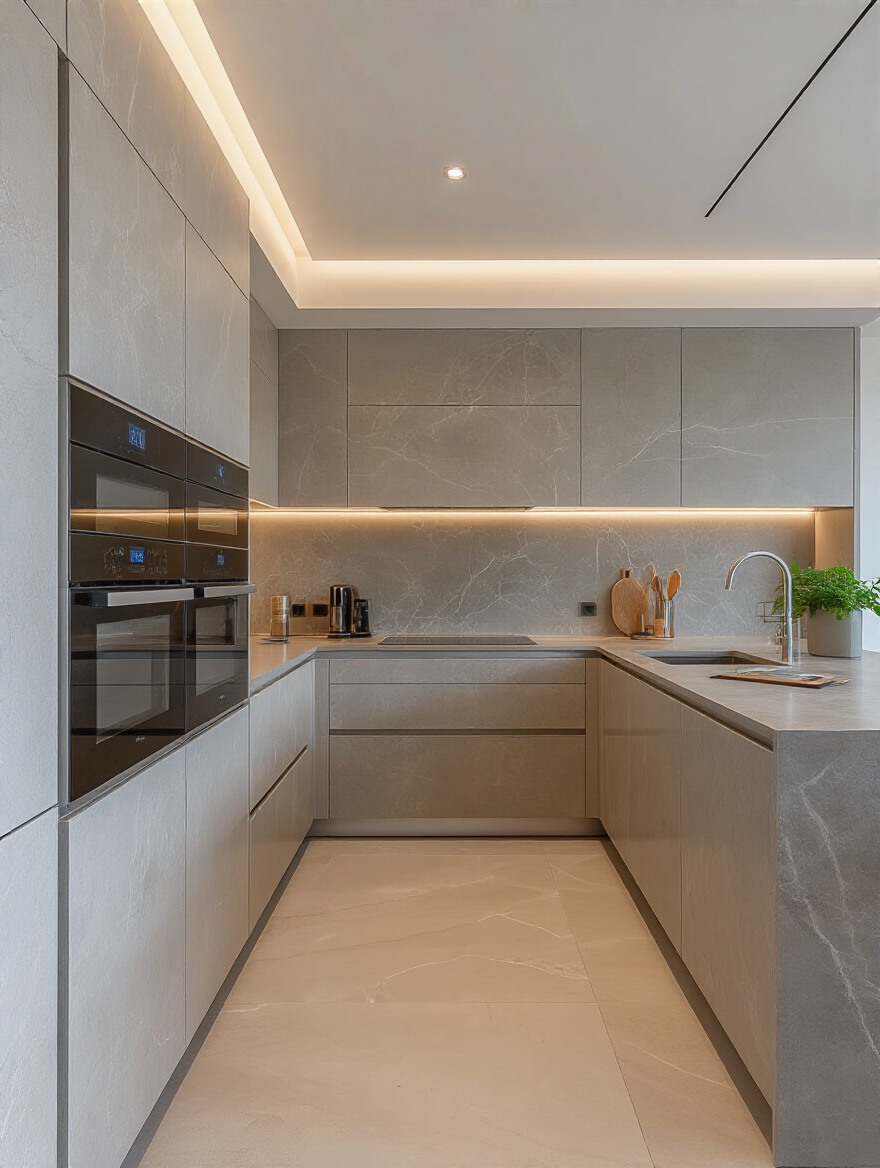
The real wins are things like automated shades on your kitchen windows that adjust based on the sun’s angle, preventing glare and heat gain without you lifting a finger. Or integrated speakers that seamlessly play music both in the kitchen and on the patio. Plan the wiring for this from the start. Trying to retrofit it later is a messy, expensive nightmare. Think about tech as the invisible infrastructure that makes living with nature more comfortable.
The biggest BS is that you need every single appliance to be “smart.” You don’t. Focus on the infrastructure—good Wi-Fi that reaches the patio, outlets in the right places (including weatherproof ones outside), and wiring for lighting and sound. That’s the shortcut to a future-proofed home that truly works for you.
6. Evaluate Wall Removal Potential for Open Concept Living Expansion
Everyone talks about removing the wall between the kitchen and the living room. And that’s fine. But I’m going to challenge you to think about a different wall: the one between your kitchen and the outside. This is often the most valuable, transformative wall you can possibly remove.
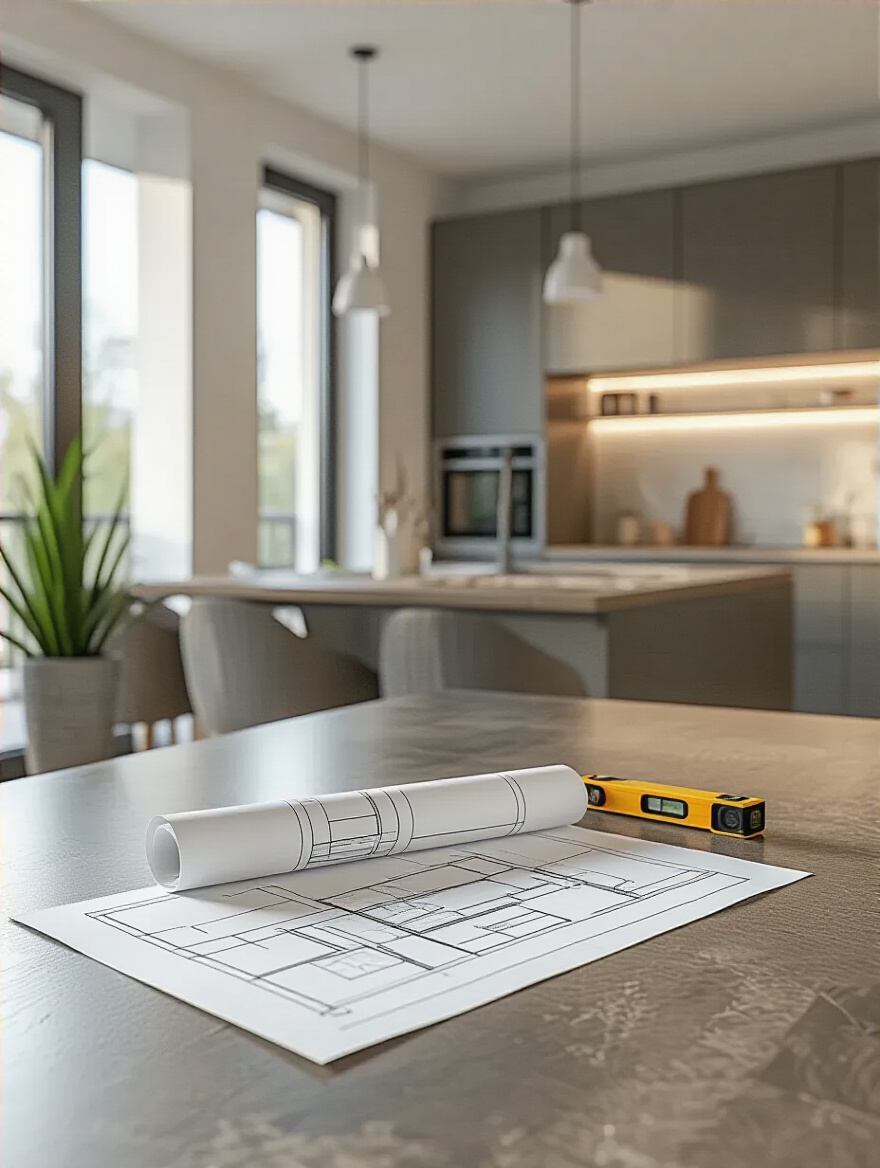
Instead of a standard window over the sink and a single door, imagine replacing that entire wall with a bank of folding or sliding glass doors. Suddenly, your kitchen and your deck become one continuous space. You’re not just looking at your garden; you’re in it. This move single-handedly does more to extend your living space and connect you to the outdoors than any other design choice you can make. It’s a big move, but the payoff in lifestyle is immeasurable.
I once worked with a family whose dark, cramped kitchen had one small window looking out onto a magnificent oak tree. We took out that entire back wall and installed floor-to-ceiling glass sliders. The transformation was breathtaking. The kitchen was flooded with dappled light, and the tree became a living piece of art. They told me later they stopped eating in their dining room entirely; every meal happened at the kitchen island, looking out at that tree.
With the big structural and flow decisions made, it’s time to get into the details that bring the space to life. The materials and fixtures you choose are the elements you’ll touch and see every single day. They need to be beautiful, functional, and consistent with this natural, connected philosophy.
Material & Fixture Selection for Enduring Style (Part 1)
This is where the tactile part of the design comes in. The goal is to choose materials that feel good, wear well, and echo the natural world. Think less “perfect and polished” and more “grounded and authentic.” Nature isn’t perfect, and your kitchen materials don’t have to be either.
7. Choose Durable Countertop Materials That Match Your Lifestyle Demands
The key here is honesty about your lifestyle. A gleaming white marble countertop is beautiful in a magazine, but if you have kids, spill red wine, or bring in herbs from the garden, it’s going to be a high-maintenance source of stress. The “what matters” is choosing a surface that can handle real life without you having to constantly worry about it.
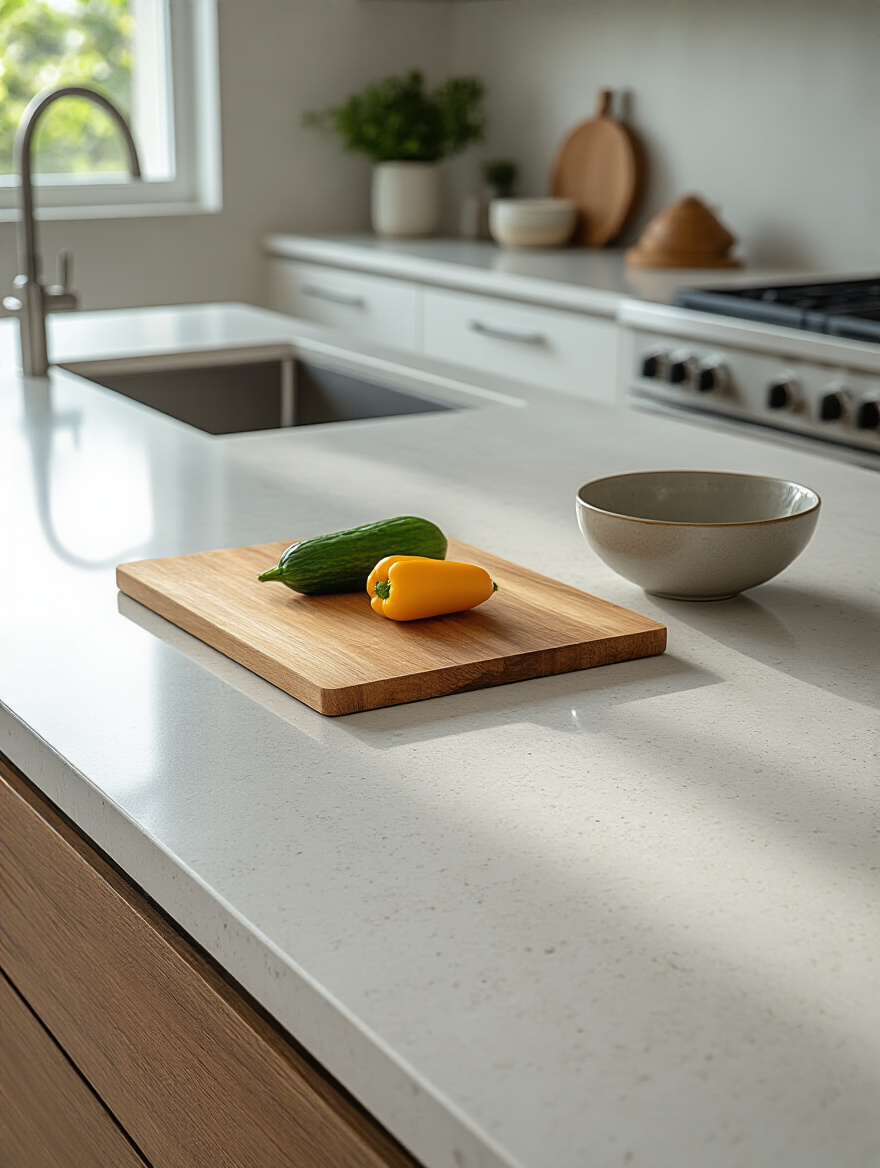
I lean towards materials that have a natural, forgiving quality. A honed (matte) granite or soapstone develops a beautiful patina over time; a few scratches just add to its character, like a well-worn leather jacket. Engineered quartz is also a fantastic, bulletproof option, especially designs that mimic natural stone or concrete. They connect to that earthy, grounded feeling without the high maintenance of their natural counterparts. The shortcut is to choose a material that will look better, not worse, with a little bit of life lived on it.
A pet peeve of mine is when people choose a highly polished, reflective countertop in a kitchen that gets a lot of direct sun. They spend all day squinting from the glare. A matte or honed finish diffuses light beautifully and feels much softer and more natural. It’s a small choice that makes a huge difference in daily comfort.
8. Select Cabinetry Styles That Complement Your Home’s Aesthetic Cohesion
Your cabinets are the biggest visual element in the kitchen, so they need to feel right. For me, that often means connecting them to the landscape. This doesn’t have to be literal, like rustic knotty pine (unless that’s your thing). It can be much more subtle. Think about colors drawn from the outside: the soft green of new leaves, the deep blue-gray of a stormy sky, or the warm white of sun-bleached stone.
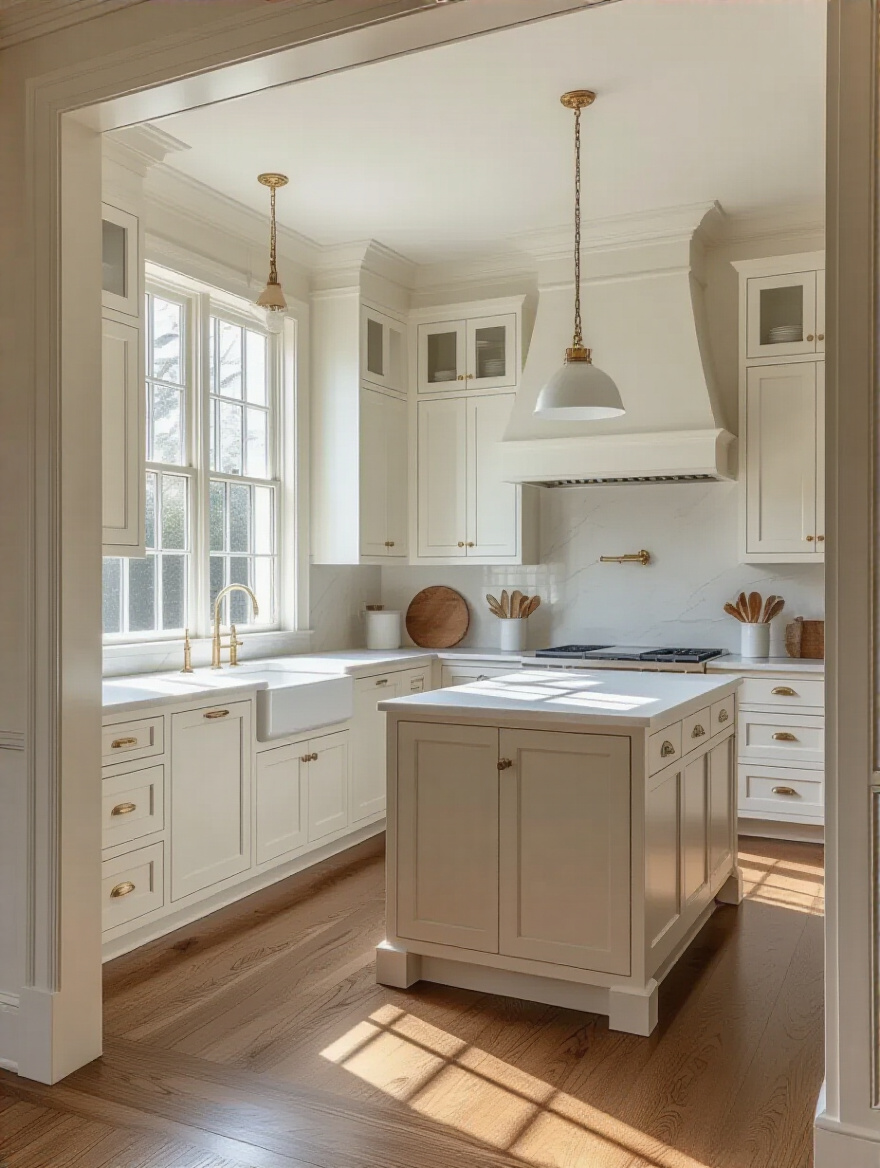
Natural wood is always a great choice. The grain and texture of a beautiful oak or walnut cabinet front brings an organic warmth that man-made materials can’t replicate. It reminds you of the forest. The key is to carry that feeling through. Don’t pair natural wood cabinets with cheap, plasticky hardware. Choose something with weight and substance, like brushed brass, oil-rubbed bronze, or matte black iron.
My advice is to avoid short-lived trends. Remember those high-gloss red cabinets from the 2000s? Instead, pick a timeless style like a simple Shaker door and let the color or wood grain be the star. This creates a calm, consistent backdrop that allows the view outside your window to be the main event.
9. Harmonize Backsplash Patterns with Countertops and Flooring Selections
The backsplash is a place to have a little fun, but it needs to play well with others. The rule of thumb I give everyone is this: you get one “star” in the kitchen. If you have a wildly patterned, dramatic countertop, your backsplash should be quiet and simple. If your countertop is solid and calm, your backsplash can be the focal point. Trying to make everything a star just creates a chaotic mess.
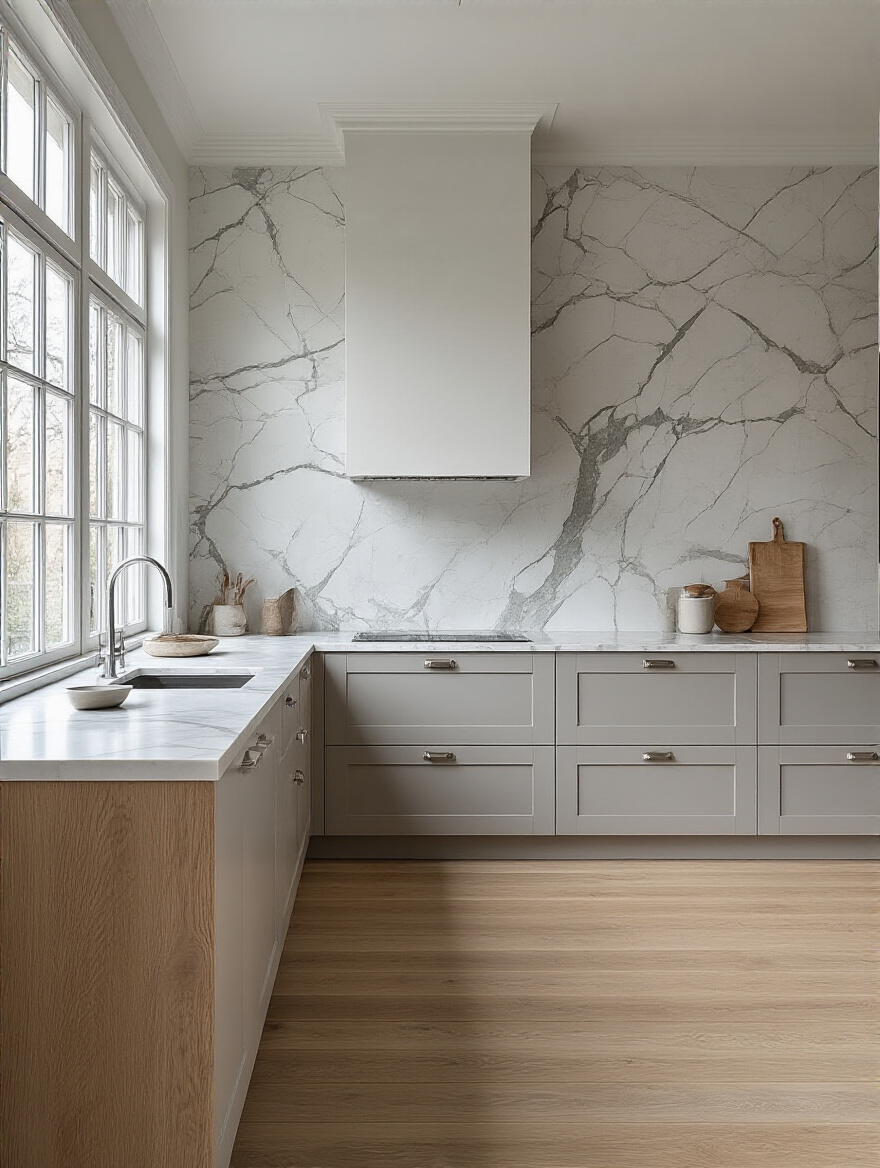
To tie into our nature-inspired theme, look for tiles that have an organic feel. Zellige tiles, which are handmade and have beautiful, subtle variations in color and texture, are a favorite of mine. They reflect light in a way that feels like water. A simple, stacked subway tile can feel very architectural, but if you choose one with a slightly uneven surface or a soft, crackle glaze, it instantly feels more handmade and grounded.
A great shortcut is to take your countertop sample and your cabinet door sample and lay them on the floor next to your flooring. Then put all your backsplash options on top. Look at them in different light. The combination that feels calm and balanced, not jarring and busy, is your winner.
10. Optimize Appliance Placement for Both Form and Seamless Functionality
This brings us back to flow. Yes, your work triangle is important, but so is how your appliances interact with the overall space, especially in an open-plan home. You don’t want a massive stainless-steel refrigerator to be the first thing you see from the living room. It can kill the vibe.
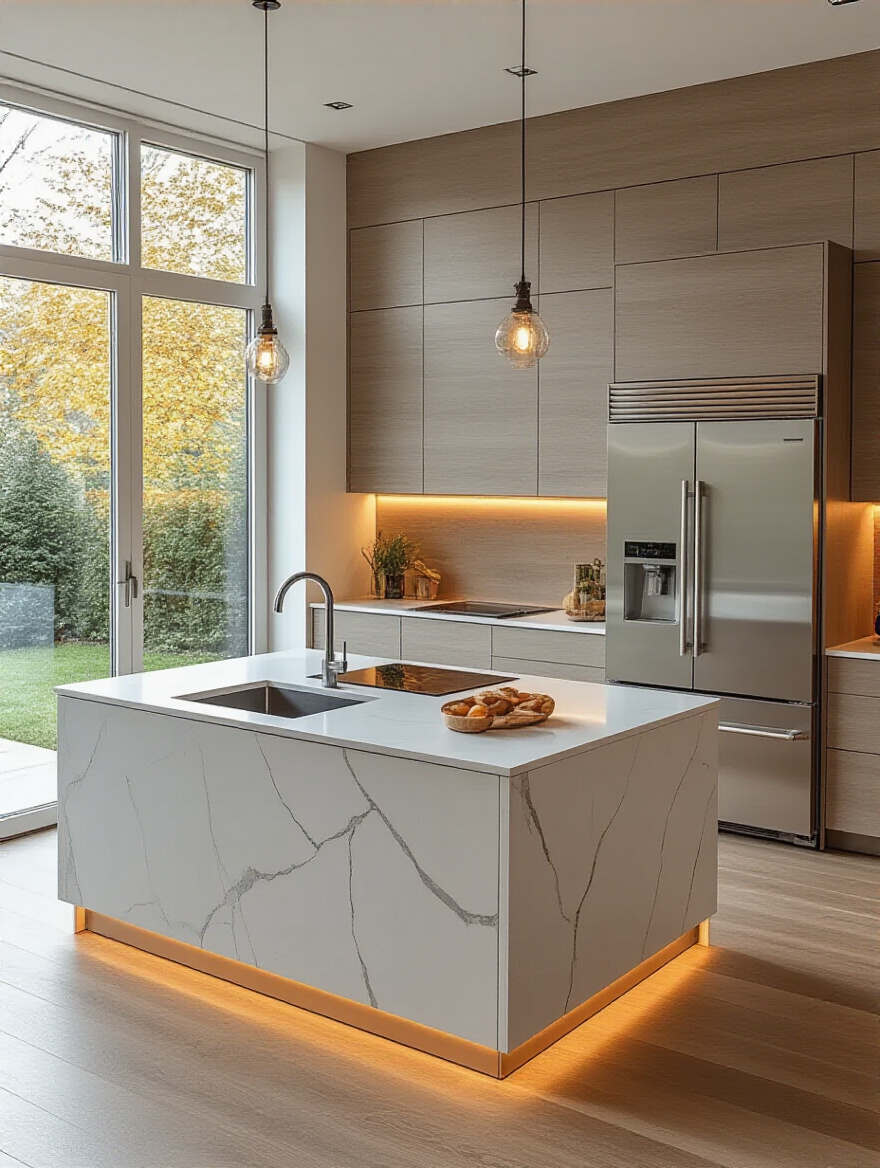
This is where integrated appliances, the kind you cover with a cabinet panel, are your best friend. They allow the kitchen to blend more seamlessly with the living area, making the whole space feel less utilitarian and more like a cohesive part of the home. This is especially important when you have a wall of glass looking outside—you want the eye to be drawn to the view, not to a collection of hulking machines.
Think about the sounds appliances make, too. A quiet dishwasher is worth every penny in an open-concept layout that connects to your outdoor living space. The last thing you want is the roar of the dishwasher drowning out the sound of birdsong or conversation on the patio. Prioritizing low-decibel appliances is a pro move for creating a serene connection between your indoor and outdoor rooms.
We’ve covered the big picture and the hard surfaces. Now, let’s talk about the unsung heroes of kitchen design: smart storage and the workhorse appliances that make life easier. These choices are less about show and more about creating a space that functions with effortless grace.
Material & Fixture Selection for Enduring Style (Part 2)
Getting these next few things right is the difference between a kitchen that looks good and a kitchen that lives good. It’s about planning for efficiency, long-term savings, and creating a space that works as hard as you do.
11. Integrate Smart Storage Solutions Beyond Basic Cabinets for Every Need
The biggest enemy of a calm, connected kitchen is clutter. Nothing ruins a beautiful view like a countertop covered in junk. The answer isn’t just more cabinets; it’s smarter storage. Think vertically. Think about what’s inside your drawers and cabinets.
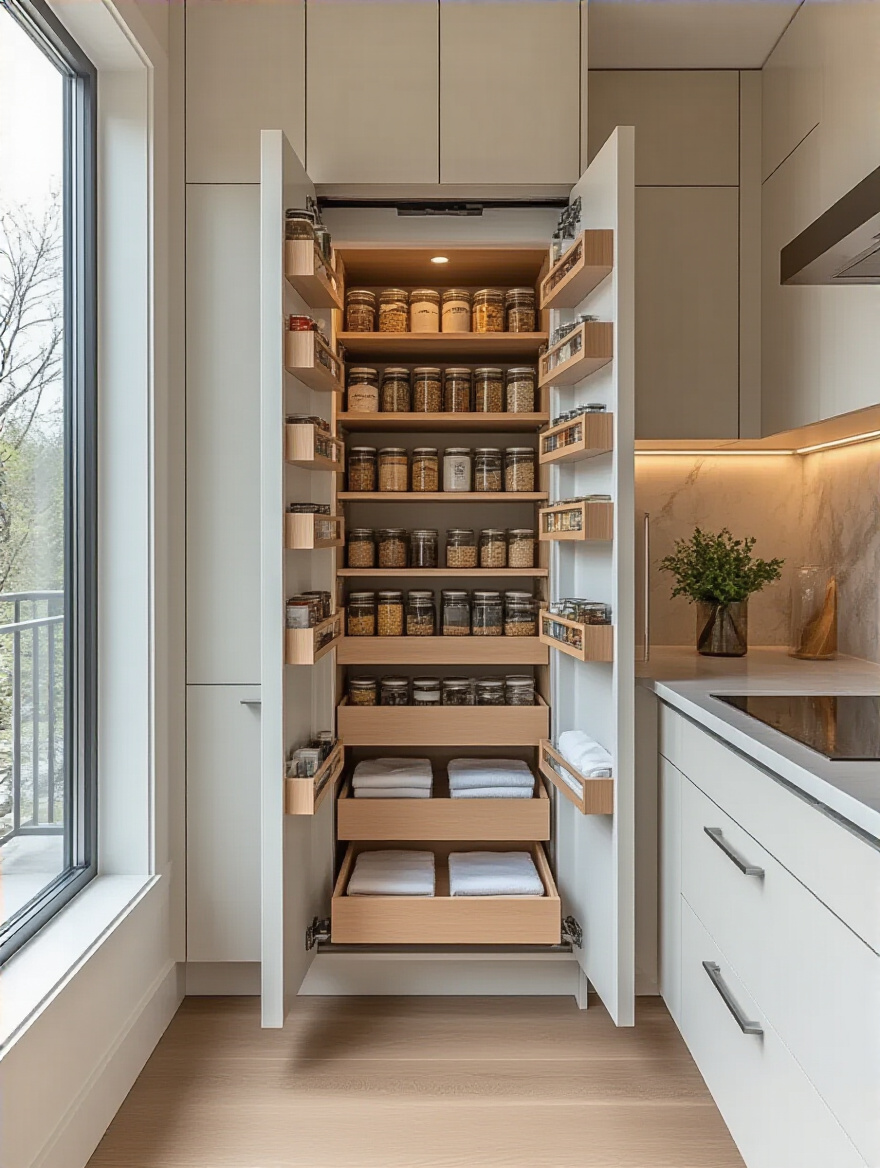
Deep drawers for pots and pans are infinitely better than deep cabinets where everything gets lost in the back. Pull-out pantries turn a narrow, useless space into a treasure trove of organized goods. Dividers for baking sheets, pull-out spice racks, a dedicated coffee station hidden behind pocket doors—these are the things that make a kitchen a joy to use. By giving everything a designated home, you keep your counters clear, which in turn keeps your sightlines to the outside world open and unobstructed.
My favorite trick? Toe-kick drawers. That 4-inch space under your base cabinets is usually wasted. You can install shallow drawers there that are perfect for placemats, baking pans, or even the dog’s water bowl. It’s a genius way to squeeze out every last bit of storage and keep your space feeling clean and expansive.
12. Prioritize Energy-Efficient Appliances for Long-Term Savings and Eco-Consciousness
This is a no-brainer. Choosing energy-efficient appliances is simply the right thing to do. It’s better for the planet and, over the long run, it’s better for your wallet. It’s a core part of working with nature, not against it.
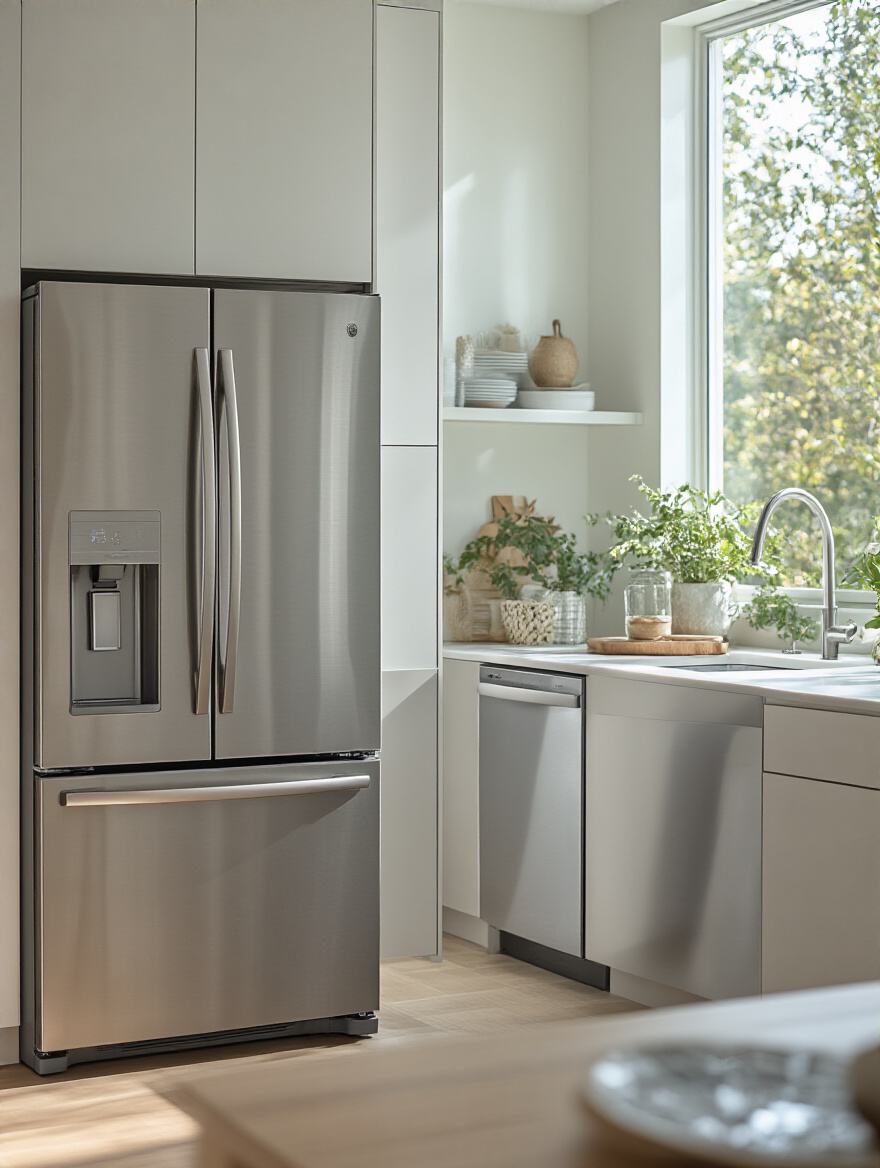
But let’s talk about one appliance in particular: the induction cooktop. I’m a huge advocate. They are incredibly energy-efficient, transferring heat directly to the pan with almost no waste. They’re also safer (the surface doesn’t stay screaming hot), and they are a dream to clean because it’s just a flat glass surface. From a design perspective, their sleek, minimalist look helps maintain that clean, uncluttered aesthetic we’re aiming for, allowing the beauty of your materials and the view to shine.
Don’t fall for the line that you need a massive, six-burner professional gas range to be a serious cook. I learned that the hard way when I installed one and realized it was total overkill for my family and a beast to clean. An induction cooktop offers more precise temperature control and efficiency. It’s the smarter, more modern, more eco-conscious choice.
Now for the magic. We’ve built the functional bones, and now it’s time to layer in the elements that create mood, personality, and soul. This is how you make the kitchen feel less like a workspace and more like your favorite room in the house.
Enhancing Ambience with Lighting, Color & Creative Storage (Part 1)
This is where art meets science. Ambience isn’t accidental; it’s designed. A thoughtful approach to light, color, and how you display your cherished items can transform a functional box into a warm, inviting heart of the home.
13. Design Layered Lighting to Create Mood and Task Functionality Independently
One overhead light in the middle of the kitchen is a cardinal sin. It casts shadows exactly where you don’t want them—on your countertops while you’re trying to chop vegetables. Good lighting is layered: ambient, task, and accent. Ambient is the general overhead light. Task is focused light for workspaces, like under-cabinet LEDs. Accent is for mood, like a beautiful pendant over an island.
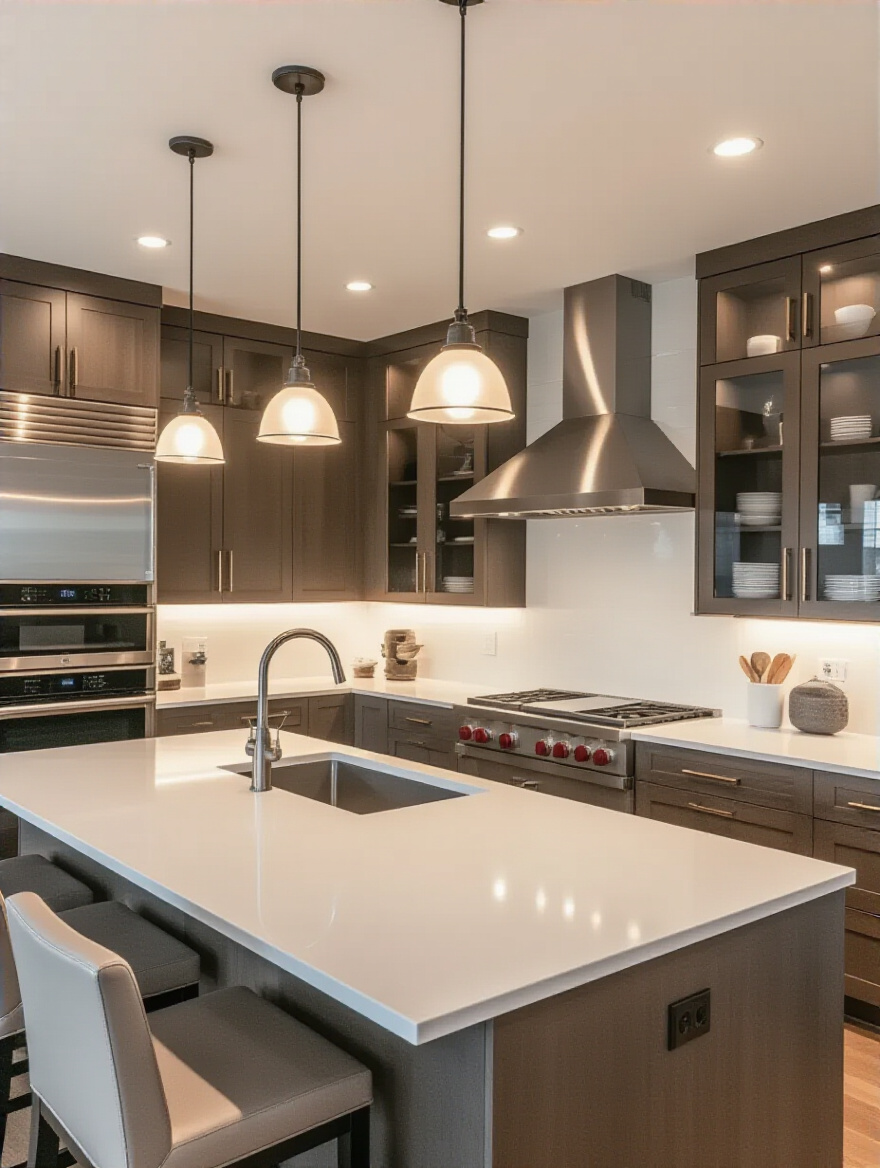
Here’s the nature-inspired part: every single light should be on a dimmer. This is non-negotiable. It allows you to tune the light in your kitchen to match the light outside. On a bright, sunny day, you might just need a little task lighting. As dusk settles, you can bring up the warm, ambient light to create a cozy glow that mimics the sunset. It’s about creating a seamless transition between the light indoors and the natural light outdoors.
I once consulted on a kitchen where the owner complained it felt “cold and clinical” at night. They had powerful overhead LEDs and nothing else. We simply added warm, under-cabinet lighting and put everything on dimmers. It completely changed the space from a lab to a lounge with the flick of a switch. It’s the cheapest, most effective way to control the mood of a room.
14. Infuse Personality with a Thoughtful Color Palette Selection that Inspires
The easiest way to find a can’t-miss color palette for your kitchen? Look out the window. Nature is the best color consultant there is, and it never gets it wrong. Pick up the colors from your garden, the trees in the distance, the stone on your patio, or the color of the sky at your favorite time of day.
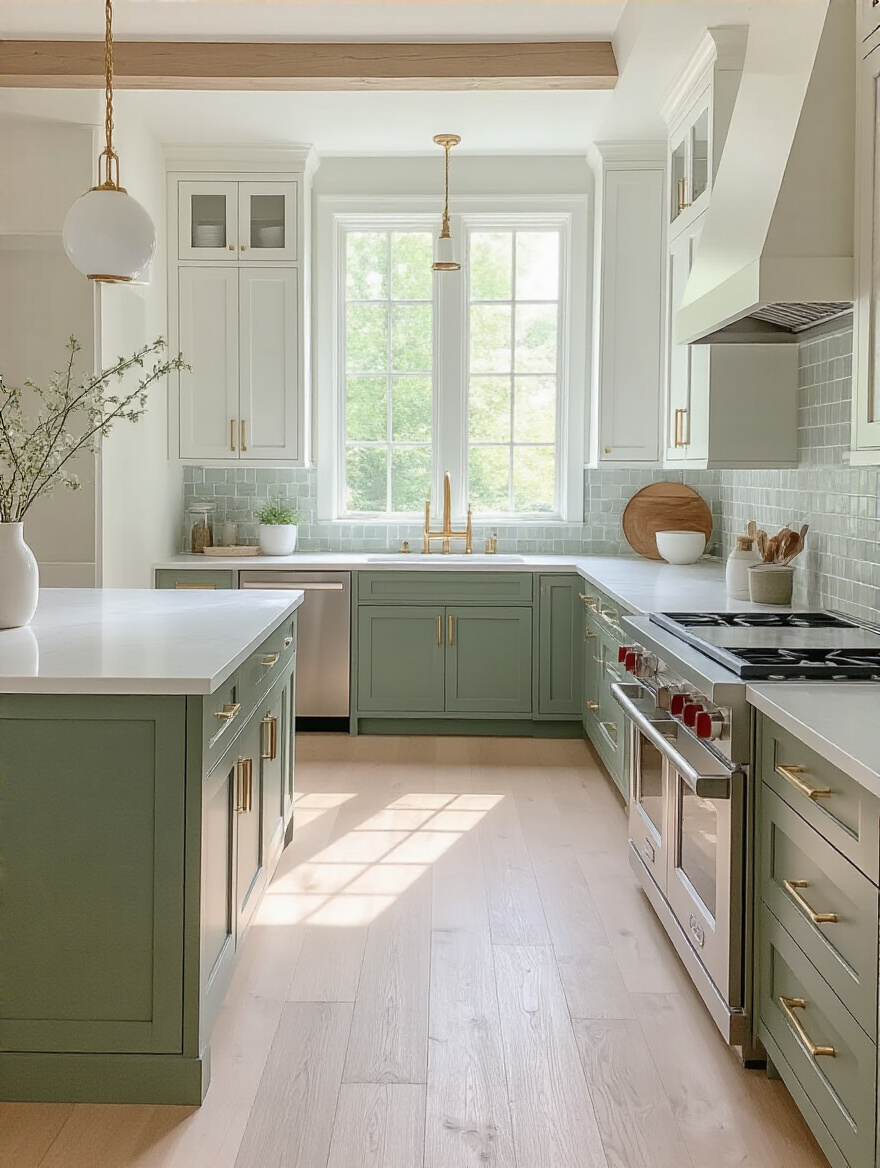
This doesn’t mean you have to paint your walls grass green. It’s about capturing the feeling of those colors. If you have beautiful slate stonework outside, use a deep charcoal for your island base. If your garden is full of lavender, a dusty, muted purple could be a stunning accent. Using colors that are native to your home’s specific environment creates an unconscious sense of harmony. Your kitchen will feel like it truly belongs to its location.
The BS to ignore is the “color of the year.” Trends are fun, but your kitchen is a long-term investment. A palette inspired by your home’s natural surroundings will feel right for decades, long after the trendy color has come and gone. Stand in your space, look outside, and let the landscape tell you what color it wants to be.
15. Maximize Vertical Storage to Efficiently Declutter Countertops and Spaces
We talked about smart storage inside cabinets, but let’s talk about the walls. Taking storage vertical is key, especially in smaller kitchens. A wall of tall pantry cabinets can hold an incredible amount, freeing up the rest of the kitchen to feel more open and airy. But it’s not just about closed cabinets.

A few well-placed open shelves can be beautiful. This isn’t for your mismatched Tupperware. This is for your beautiful ceramic bowls, a few favorite cookbooks, and a small potted plant or two. It breaks up a solid wall of cabinetry, adds personality, and makes the space feel lighter. The trick is to keep it curated. Think of it as a gallery wall you can also eat off of.
My advice: limit open shelving to one or two key areas, like next to a window or over a coffee bar. This gives you that airy, personalized look without creating a lot of visual clutter or a cleaning headache. It’s a focal point, not your primary storage solution.
16. Incorporate Statement Seating for Gathering and Casual Dining Experiences
The kitchen island has replaced the dining room table as the center of family life. This is where homework gets done, conversations happen, and friends gather with a glass of wine. The seating here needs to be comfortable and inviting. Forget those hard, backless metal stools that look cool but are miserable to sit on for more than five minutes.
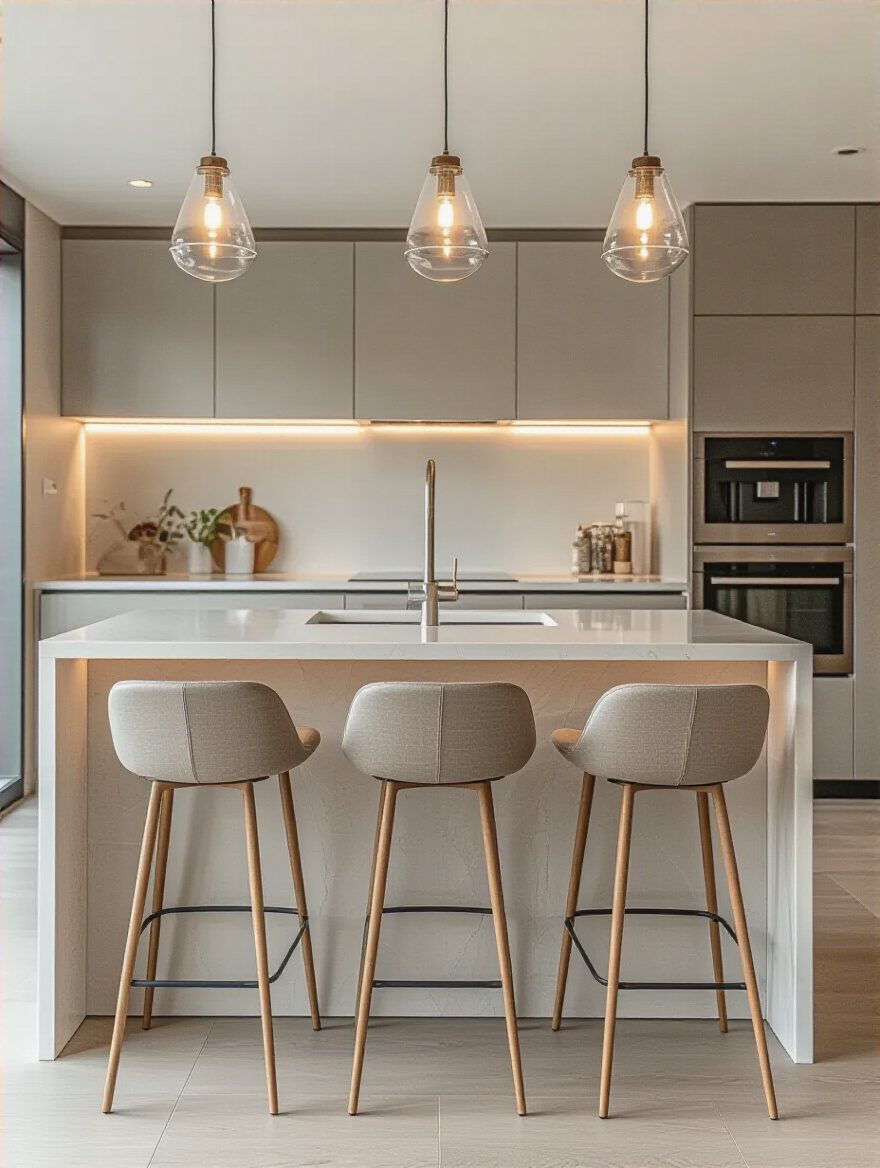
Choose counter stools with a back, some cushioning, and a place to rest your feet. Think of them as actual chairs. And if you have the space, there’s nothing better than a built-in banquette or window seat. It’s the coziest spot in the house, perfect for morning coffee while looking out at the garden. It turns a functional corner into a destination.
I once designed a kitchen for a family with a large picture window that looked out onto their backyard. We built a long, upholstered window seat along the entire wall with a simple table in front of it. It became command central for the whole family. It proved that the best seat in the house is always the one with the best view.
We’re getting down to the finishing touches. These are the details that elevate a kitchen from “well-done” to “wow.” Think of them as the jewelry—the small, personal choices that tie the whole look together and make it uniquely yours.
Enhancing Ambience with Lighting, Color & Creative Storage (Part 2)
Don’t underestimate the power of these final layers. Hardware, fixtures, and thoughtfully displayed items are what give a kitchen its soul. This is where you move beyond formulas and inject pure personality into the heart of your home.
17. Select Hardware and Fixtures That Elevate the Overall Design Scheme
Hardware is a small detail that has a huge impact. It’s the one thing you physically touch every time you use your kitchen, so it needs to feel good in your hand. This is a place to invest in quality. Solid brass, bronze, or hand-forged iron has a weight and a patina that cheaper, plated options just can’t match.
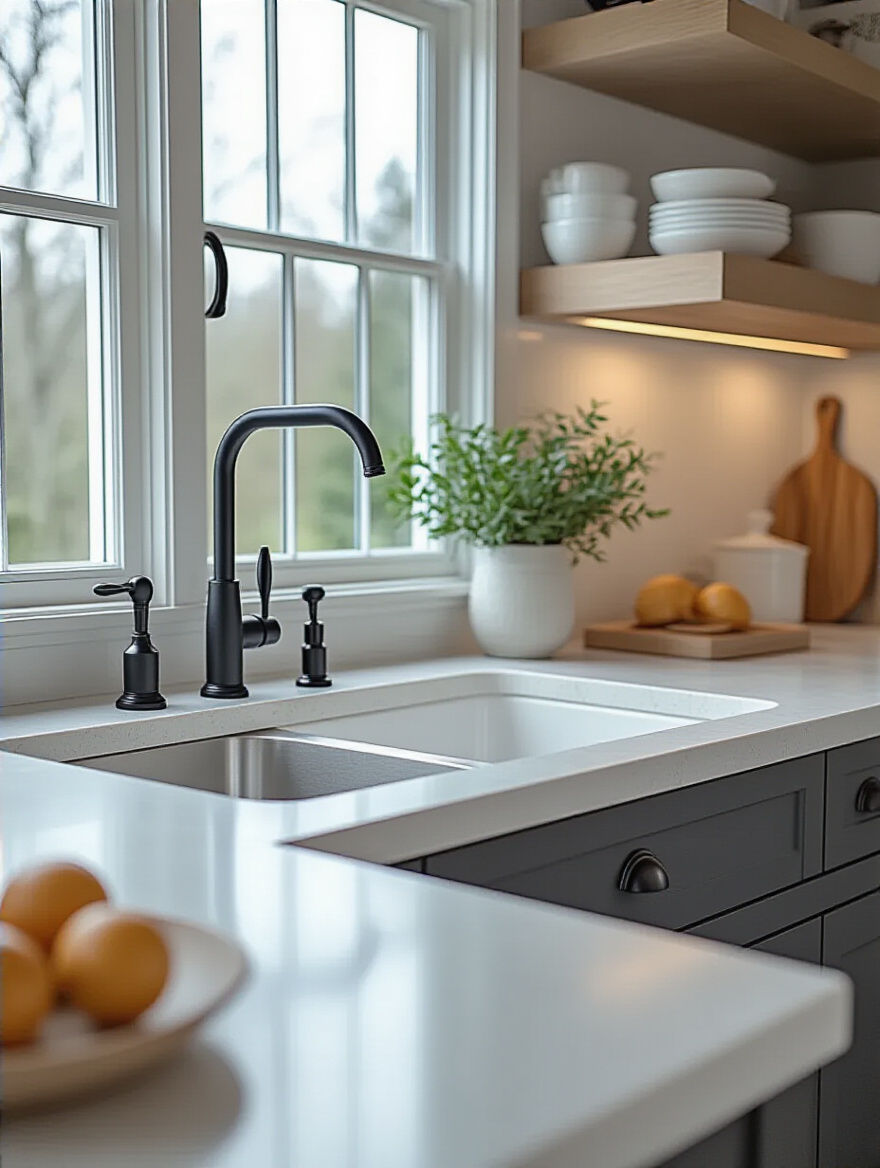
Think of your faucet as a functional sculpture for your sink. A beautiful gooseneck faucet in a warm brass or a sleek matte black can be a stunning focal point. Look for designs that feel classic and timeless. The goal is for your hardware and fixtures to feel like they’ve always been there, a natural and integral part of the space.
Here’s a shortcut I wish I’d known earlier: it’s okay to mix metals! Don’t feel like your stainless steel appliances mean you have to have a stainless steel faucet and cabinet pulls. Pairing a warm metal like brass or bronze with the coolness of stainless steel adds depth and character. Just keep it limited to two or three finishes to avoid it looking chaotic.
18. Curate Open Shelving Displays with Purposeful Decor and Essential Items
As I said before, open shelving is for your beautiful things. The key is “curate.” This means being selective. A great way to start is by gathering everything you think you want to display on your dining table. Then, edit ruthlessly. Group things by color or material. Stack books horizontally to create platforms for smaller objects. Add a natural element—a piece of driftwood, a small vase with a single branch, or a collection of stones from a favorite beach.
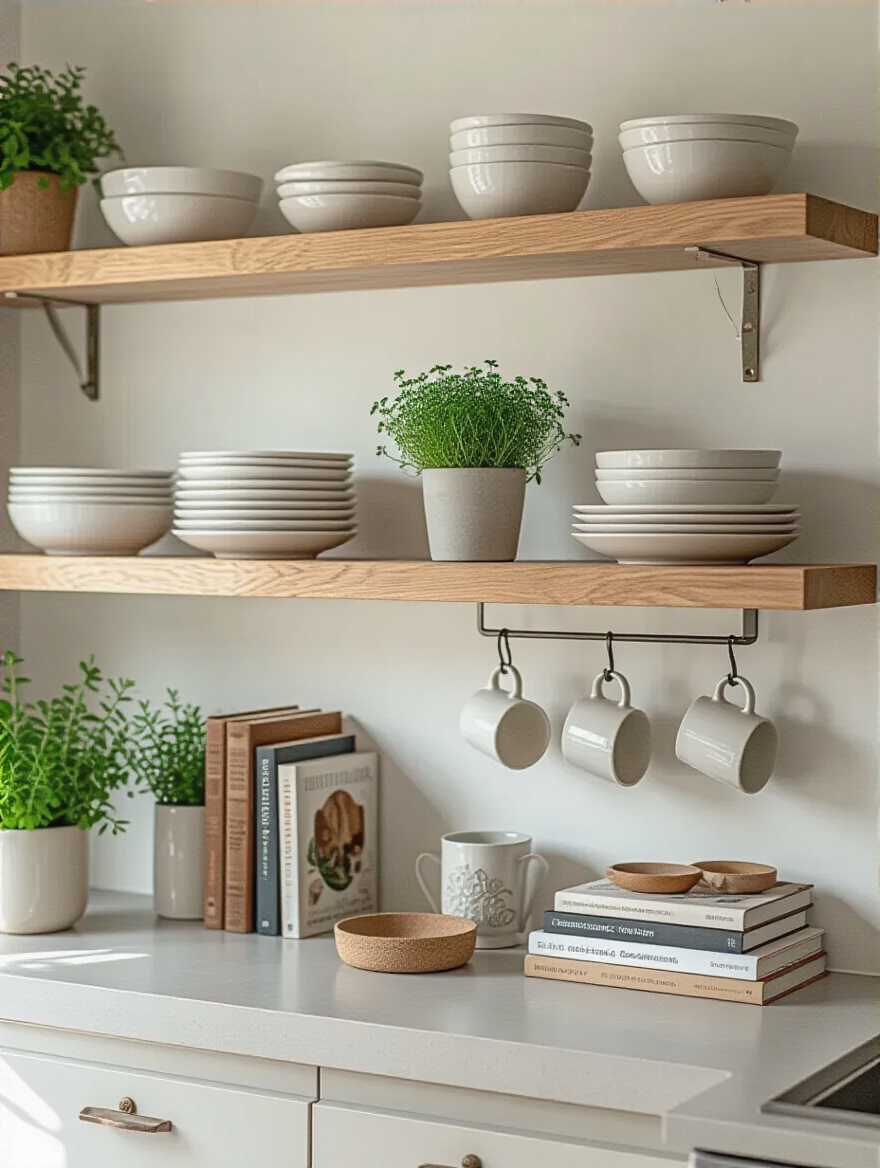
This is the perfect place to grow a few small pots of herbs like basil or mint. They add a splash of green, smell amazing, and are practical for cooking. It’s the ultimate expression of bringing the garden inside. The display should feel personal and alive, not like a static store display.
Remember to leave some empty space. The “negative space” is just as important as the objects themselves. It gives the items room to breathe and keeps the shelves from looking cluttered. Your display should tell a small story about who you are.
We’re at the finish line. These last ideas are about advanced thinking—how to infuse your kitchen with a deeper sense of well-being, make it truly one-of-a-kind, and ensure your design investment lasts for the long haul.
Advanced Design Integration & Future-Proofing (Part 1)
This is next-level stuff. When you integrate these concepts, your kitchen transforms from a collection of well-designed parts into a holistic, living space that supports your health, reflects your soul, and connects you more deeply to the natural world.
19. Integrate Unique Island Designs for Multipurpose Utility and Focal Appeal
Let’s rethink the kitchen island. Instead of just a big block in the middle of the room, what if it was designed more like a piece of high-functioning furniture? A “waterfall” island, where the countertop material flows down the sides, can look like a beautiful, monolithic stone sculpture. An island made from a different material than the perimeter cabinets—like a rich walnut against painted cabinets—can make it feel like a cherished, standalone piece.
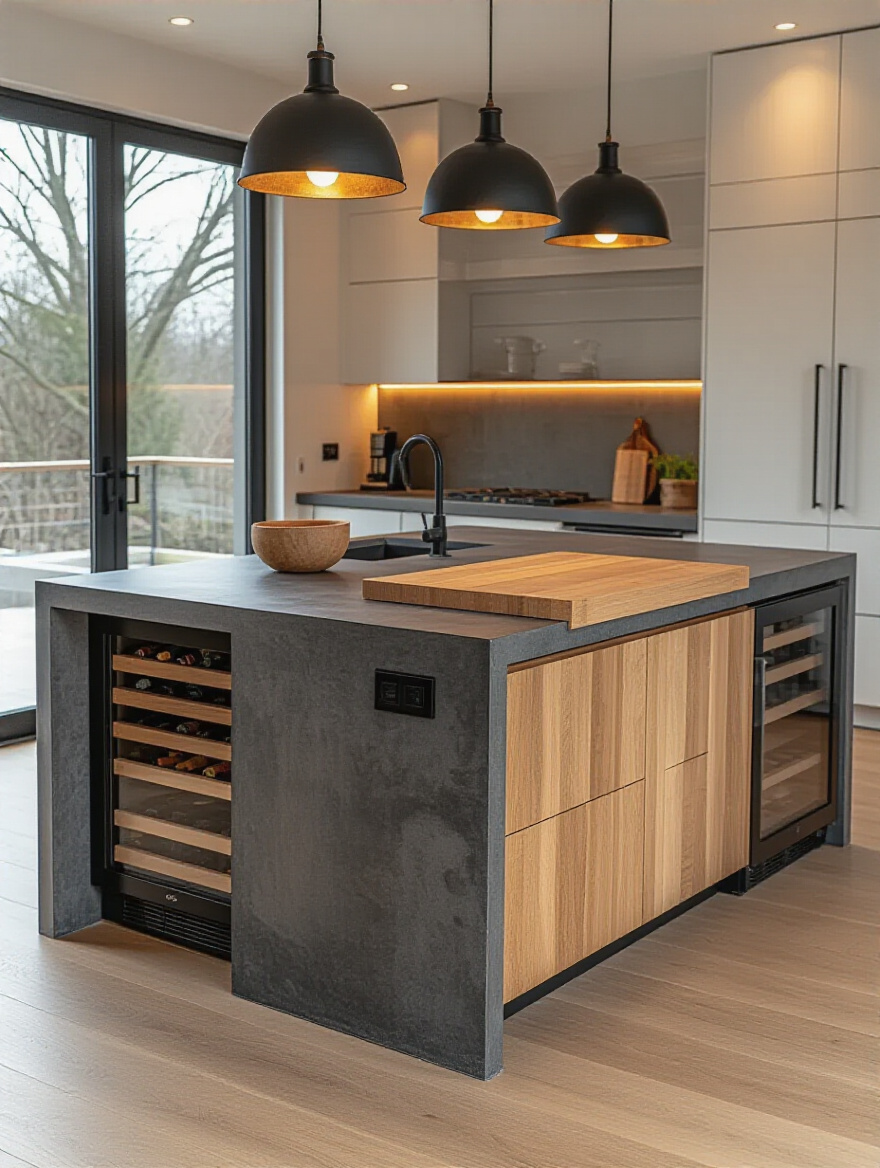
Think about multiple levels. A lower, wood-topped section can create a comfortable, table-height dining spot. You can even integrate planters into the island itself for a built-in herb garden. It’s about designing a feature that not only works hard but also makes a powerful statement about the natural, organic aesthetic of your home.
A design I love is the “trestle” island, which is open underneath with supportive legs, like an old farmhouse table. It feels much lighter and less massive than a solid block of cabinets, and you can tuck stools completely underneath, keeping pathways clear when they aren’t in use.
20. Explore Sustainable and Eco-Friendly Material Options for a Greener Kitchen
Choosing sustainable materials isn’t a trend; it’s a responsibility. And luckily, many of the most beautiful, authentic materials are also the most eco-friendly. Reclaimed wood, with its history and character, is a fantastic choice for shelves, beams, or even cabinet fronts. Bamboo is a rapidly renewable grass that makes for beautiful and incredibly durable flooring.
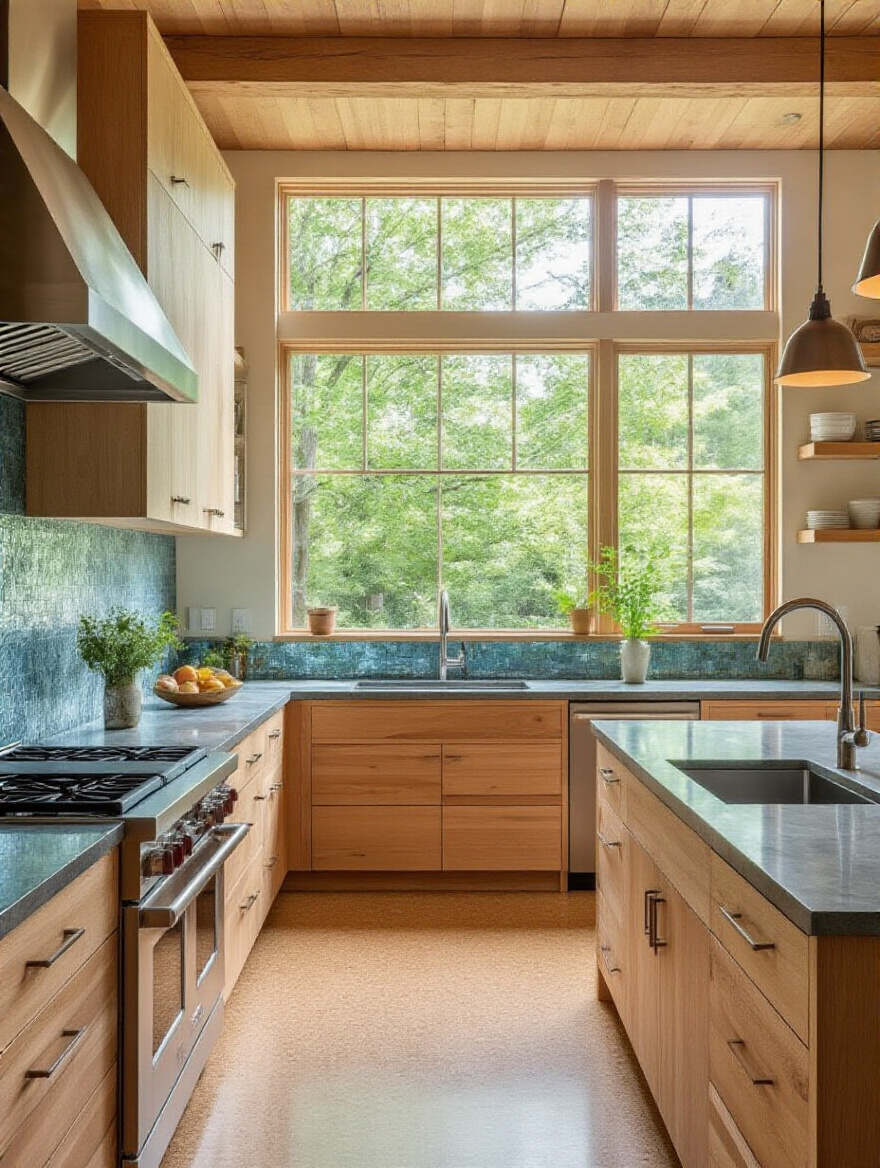
For countertops, look at options made from recycled materials, like recycled paper composites (which develop a gorgeous, leathery patina) or recycled glass set in concrete. These choices add a unique story to your kitchen. They’re conversation starters. They show a commitment to mindful living that goes beyond just aesthetics.
The BS to avoid is “greenwashing.” Just because something is “natural” doesn’t mean it’s sustainable. Marble and granite are natural, but quarrying and transporting heavy stone slabs from halfway around the world has a huge environmental footprint. Sourcing materials locally whenever possible is one of the most sustainable things you can do.
21. Personalize Your Space with Bespoke Art and Curated Accessories
Why shouldn’t you have art in your kitchen? It’s the room you spend the most time in. A beautiful painting, a stunning photograph of a landscape, or even a collection of antique ceramic platters hung on a wall can completely elevate the space. It’s an unexpected touch that signals this is a room for living, not just for cooking.

Think beyond the walls. A beautiful, handcrafted wooden bowl for fruit, a unique pottery vase for flowers from the garden, even a high-quality salt cellar and pepper mill can feel like small, functional sculptures that add daily pleasure to your routine. This is about surrounding yourself with objects that have meaning and beauty.
I confess, I used to think art was too precious for a kitchen. Then I inherited a beautiful landscape painting from my grandfather. The only place it fit was in our kitchen. I was nervous about it at first, but it completely changed the room. It gave the space a focal point and a soul. Now, I can’t imagine the kitchen without it.
22. Incorporate Biophilic Elements for a Natural Connection and Calmness
This is the heart of my entire philosophy. Biophilic design is the practice of connecting people and nature within our built environments. It’s not just about adding a few potted plants. It’s about using natural materials, natural patterns, and, most importantly, providing direct access to nature itself.
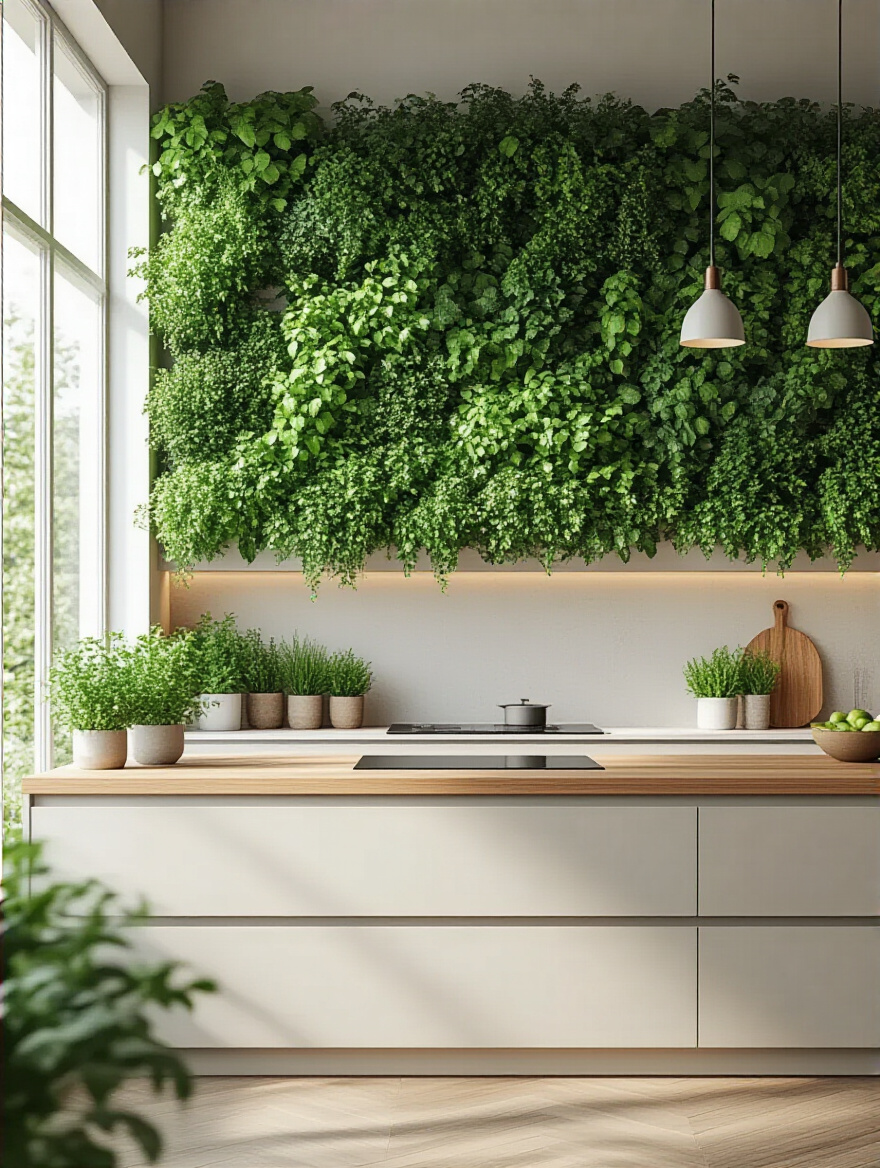
We’ve touched on this all along: a window over the sink with a view of the garden, using wood and stone, borrowing colors from the landscape, growing herbs on your shelves. All of these are biophilic principles. A living wall of herbs is the ultimate expression of this—it’s beautiful, it improves air quality, and it provides fresh ingredients for your meals. It is a living, breathing part of your home.
Even small things count. The pattern of veining in a stone countertop mimics patterns found in nature. The grain of a wood cabinet does the same. By consciously choosing these elements, you create a space that is scientifically proven to reduce stress and improve well-being. It’s about designing a kitchen that doesn’t just feed your body, but also nourishes your soul.
We have one last, crucial point to cover. This is the one that protects all the other decisions you’ve made, ensuring your beautiful, nature-inspired kitchen stays that way for years to come.
Advanced Design Integration & Future-Proofing (Part 2)
It’s easy to get swept up in the beauty of a new design. But the real test of a great kitchen is how it looks and feels five or ten years down the road. This final idea is all about ensuring your investment stands the test of time and real-world living.
23. Plan for Easy Maintenance to Preserve Your Design Investment Over Time
A beautiful kitchen that’s a nightmare to clean will quickly lose its charm. Ease of maintenance must be a primary consideration from the very beginning. The truth is, a space that seamlessly connects to the outdoors is going to see a bit more of the outdoors—a little dust, a few leaves, maybe a muddy paw print or two. Your materials need to be able to handle it.
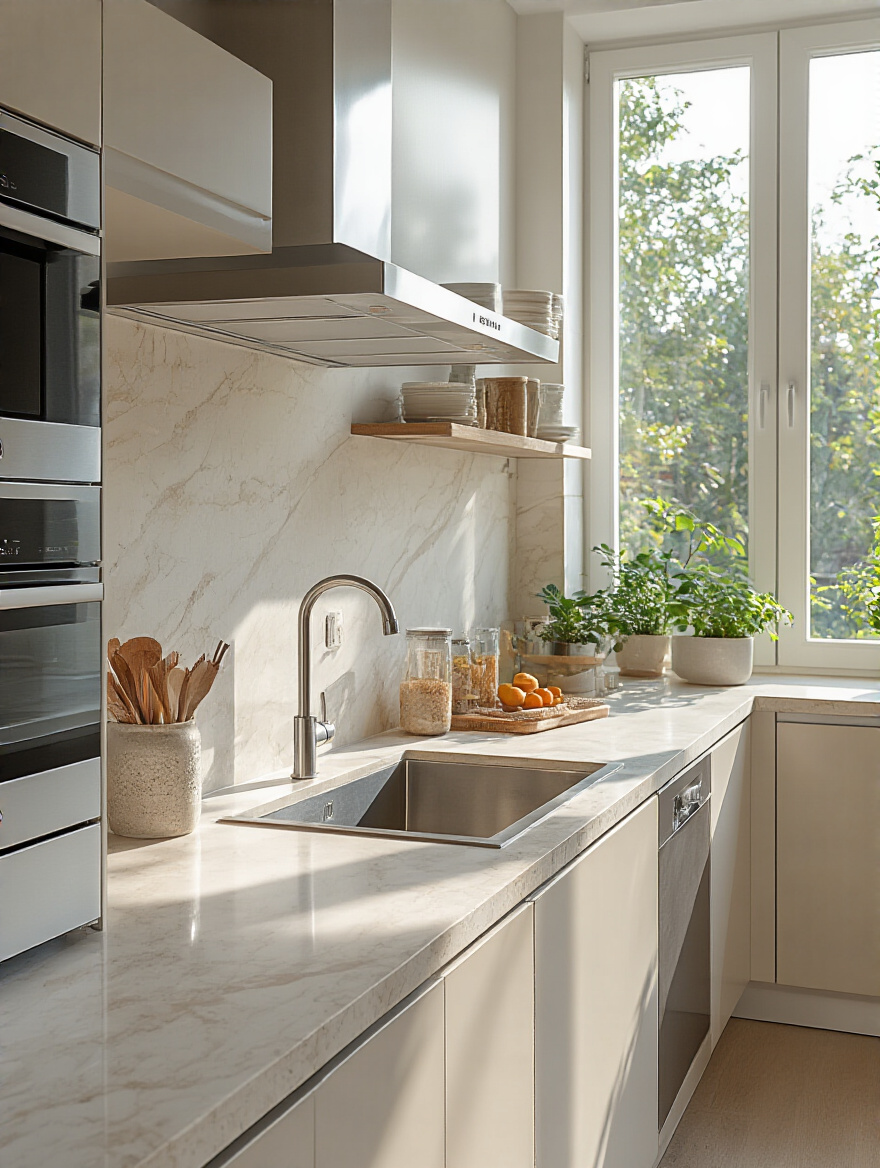
This is why I advocate for materials like engineered quartz or honed stone—they don’t show every single fingerprint and are easy to wipe clean. A seamless backsplash, like a single slab of stone or porcelain, eliminates grout lines, which are a notorious trap for grease and grime. Induction cooktops are a breeze to clean compared to grates on a gas stove. These choices aren’t just practical; they’re an act of kindness to your future self.
A classic mistake is choosing a floor with wide, light-colored grout lines. It looks great for about a week. I learned this the hard way in my first home. I spent years on my hands and knees scrubbing those grout lines. Now, I always recommend large-format tiles with the thinnest, darkest grout line possible, or better yet, a continuous surface like hardwood or cork. Your time is too valuable to spend it scrubbing.
Conclusion
So there you have it. This isn’t just a list of kitchen trends. It’s a philosophy. It’s about seeing your kitchen not as an isolated room, but as the command center for a more connected, nature-centric life. It’s the bridge between the shelter of your home and the wild beauty of the world outside your door.
When you start to see it that way, every decision—from where you put the sink to the color of your cabinets—takes on a new, deeper meaning. You’re not just designing a room to cook in. You’re crafting a space that encourages you to step outside, to eat under the open sky, to bring the garden’s bounty to your table, and to let the rhythm of the seasons shape your daily life. Stop thinking about just decorating a room and start thinking about designing a lifestyle. Now, go open a window and see what your kitchen really wants to be.
